The sidearms chosen by law enforcement agencies usually mark the next stage of handgun innovation.
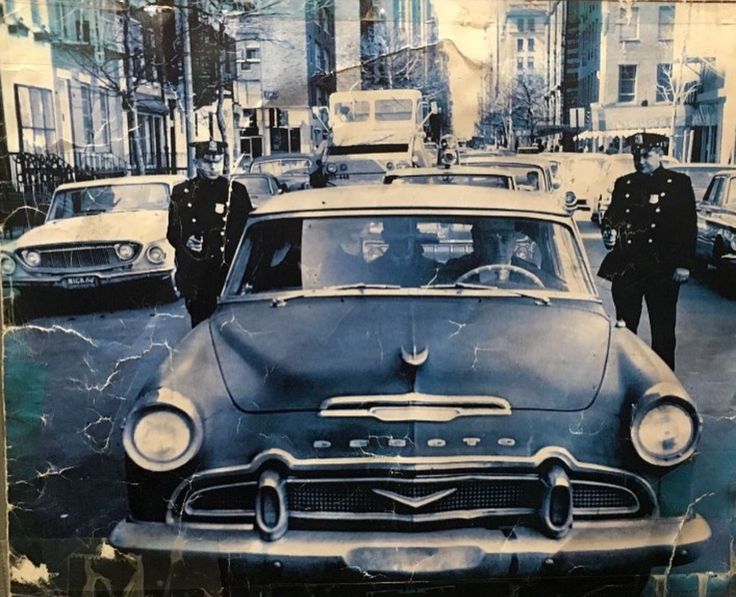
Just as the military drives rifle innovation, from the ArmaLite AR-15 in the 1960s to the .300 AAC Blackout cartridge today, when police departments start carrying a new type of handgun, civilian ownership is often not far behind.
If you want to know what’s coming down the handgun pike, then pay attention to what LEOs are carrying, because chances are that’s what will be on gun store shelves near you fairly soon.
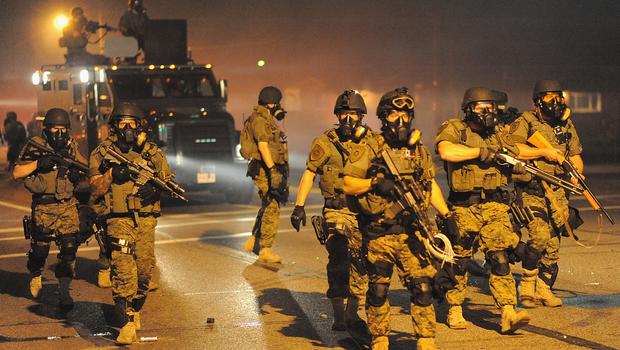
Here’s the history of police sidearms in America, from the flintlock pistols carried by the U.S. Marshals to the Glocks carried by police departments around the country today.
The Oldest Force and Flintlock Pistols
The oldest law enforcement agency in the United States is the U.S. Marshals Service. It dates to 1789, when George Washington appointed 13 men—one for each state—as part of the Judiciary Act.
These officers were crucial to establishing a federal judiciary system through local ties. The first recorded U.S. Marshal was Lieutenant Colonel Nathaniel Ramsay of the 3d Maryland Regiment.
According to the Society of Cincinnati of Maryland, the Old Line State bought weapons for its militia through “firms like Halbach & Sons of Baltimore, which imported as well as manufactured guns during the Revolutionary War.” The most popular was a flintlock pistol that cavalry units preferred.
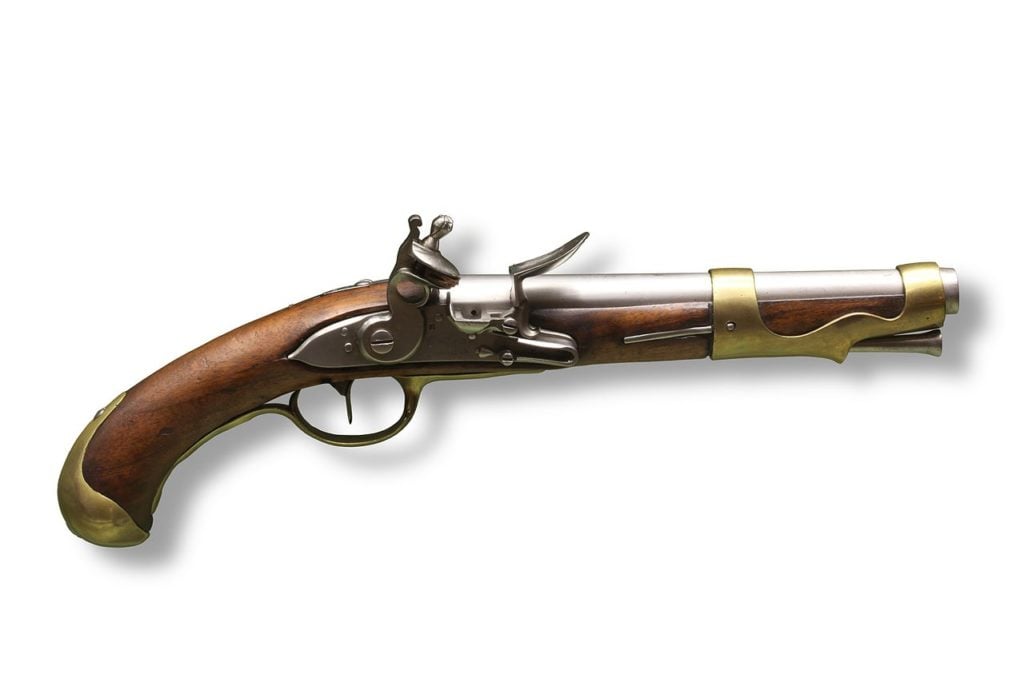
The flintlock technology meant that the lock, or ignition mechanism, was flint—a substance able to ignite the gunpowder instantly, reliably and regardless of weather.
While Ramsay’s 3d Maryland was a military infantry unit, it’s reasonable to think that as the first designated federal marshals, Ramsay and his colleagues might also have carried flintlock pistols—which remained the standard sidearm weapon of the day until the mid-1800s.
Second Oldest and Single Action
The Texas Rangers take pride in being America’s second-oldest law enforcement agency, officially constituted in 1835.
They began as 56 men in three companies “retrieving cattle, escorting refugees, and destroying supplies and equipment” as Texas struggled to gain its independence from Mexico.
Not quite military but not quite police either, they were an armed protection force that radically changed firearms tactics. Under Captain John Coffee “Jack” Hays, the Rangers adopted the Colt Paterson five-shot .36 caliber single-action revolver.
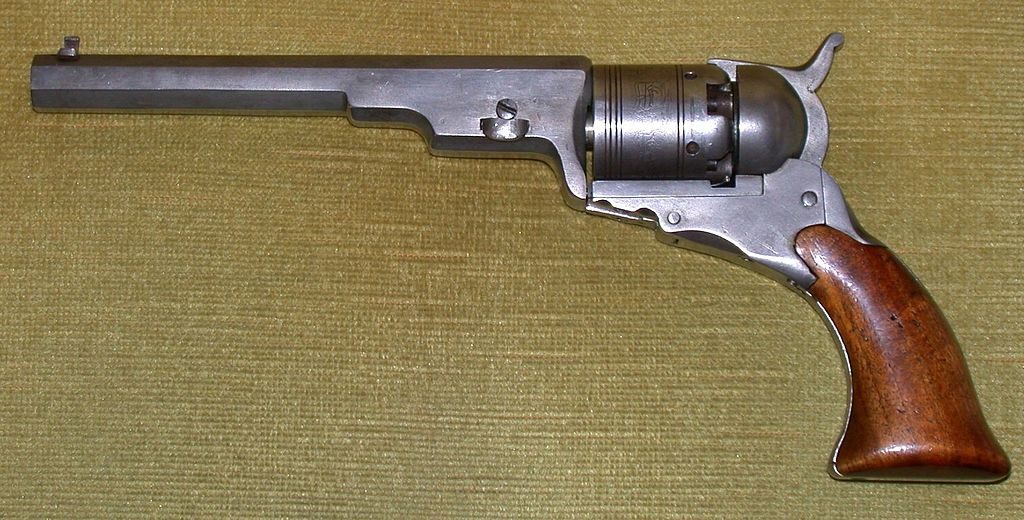
With no trigger guard, the Colt Paterson looked pretty slick for the time. It had a folding trigger that unfolded only when you cocked the hammer, which also brought the next cylinder chamber into line with the barrel.
However, it was considered too fragile for the Army; today, one of these antiques in very good condition with its original case and accessories can be worth $150,000 or more.
Nevertheless, the Rangers learned to aim, fire and reload the Paterson on horseback—a huge departure from the practice of dismounting to shoot and one that the Army quickly adopted.
The five-shot Colt Paterson eventually gave way to the famous—and sturdier—six-shot .44 caliber Walker Colt single-action revolver of 1847.
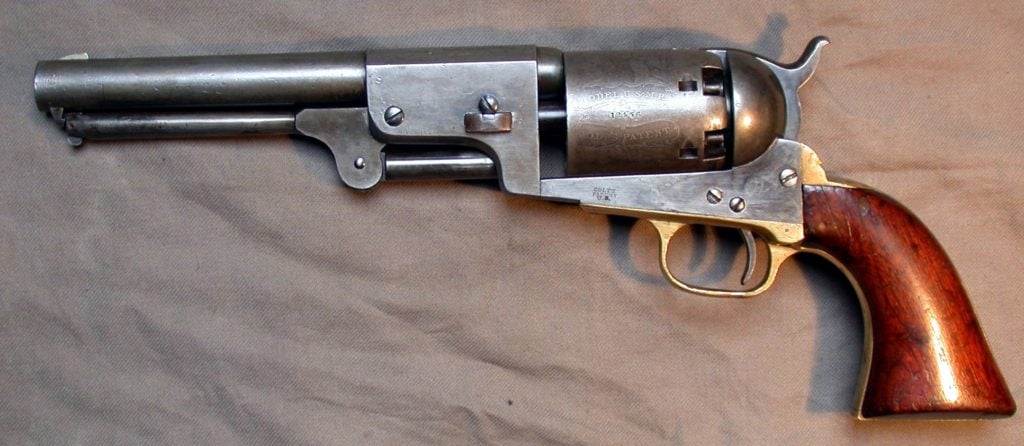
The barrel was 9 inches long, and the gun was 15½ inches in total. It weighed an ungainly 4 pounds—the carry, pommel holsters draped across the saddle.
Reportedly “as effective as a rifle at 100 yards,” it could bring down a horse as easily as a man. It remained the most powerful handgun available until the magnums of the 1930’s.
Law Legends of the West and Colt Six-Shooters
Yes, I have to go here. You’ve heard the names.
These were the legendary lawmen that the U.S. Marshals Service sent out to maintain order in the young territories. They lived and died by the firearms they carried, but Colt six-shooters were staples.
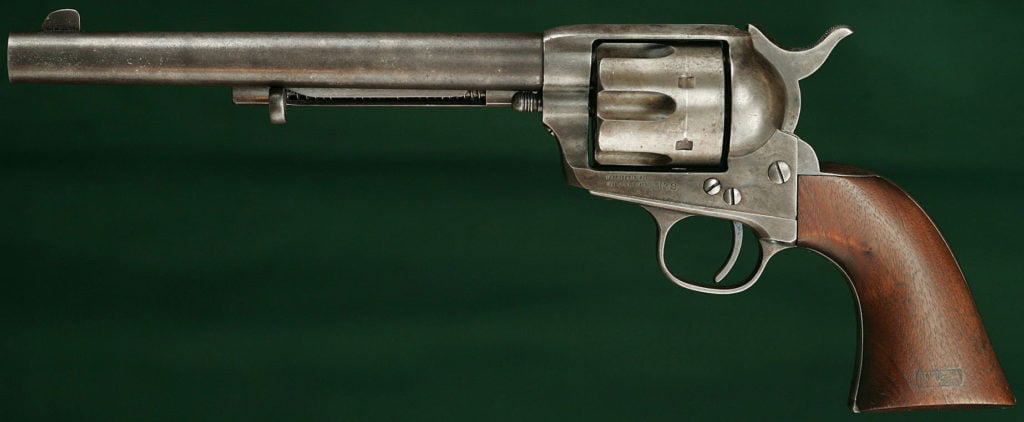
- Former Texas Ranger and Lincoln County Sherriff Pat Garrett killed Billy the Kid with a gun he’d taken from Billy Wilson, one of Kid’s gang members.
- It was a blued steel—or nickel-plated—Colt Frontier Model single-action .44-40 with a 7½-inch barrel that was later returned to Garrett’s widow in 1934.
- Garrett also reportedly carried a .38 caliber long Colt Lightning as well as a .44 caliber Smith & Wesson Russian.
- Three Guardsmen Oklahoma Territory legend Bill Tilghman carried two sidearms.
- The first was a Colt Single Action .38 special with a 5½-inch barrel.
- The second was a nickel-plated Colt .45 caliber with diamondback rattler-embossed pearl grips inscribed by Helfricht.
- One of the Dodge City greats, Bat Masterson laid claim to no fewer than eight single-action Colts.
- His second was an 1882 nickel-plated Colt Single Action Army .45 caliber revolver with a 4¾-inch barrel and ivory grips that went for $85,000 at auction in 2015.
- Another was a gold-plated Colt Single Action Army .45 caliber LC revolver with longhorn grips manufactured in 1899.
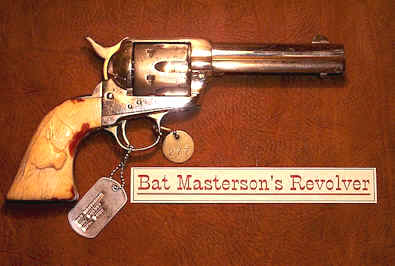
The East Coast and the Smith & Wesson Line
Back east, in 1835, Boston was the first city to establish a centralized municipal police department. New York followed suit 10 years later, with many others doing likewise in the following years.
These early police forces were, however, “notoriously corrupt and flagrantly brutal.” Much debate often surrounded their paramilitary missions and whether they should be armed at all.
New York’s police department is credited with being the first to adopt reform through rules and standardization, and sidearms were key to that initiative.
In 1885, then-police commissioner Theodore Roosevelt ordered 4,500 Colt New Police .32 caliber, six-round double-action revolvers with 4-inch barrels. He then instituted officer marksmanship qualifications, standardized weaponry and ammunition, and mandated department-wide training.
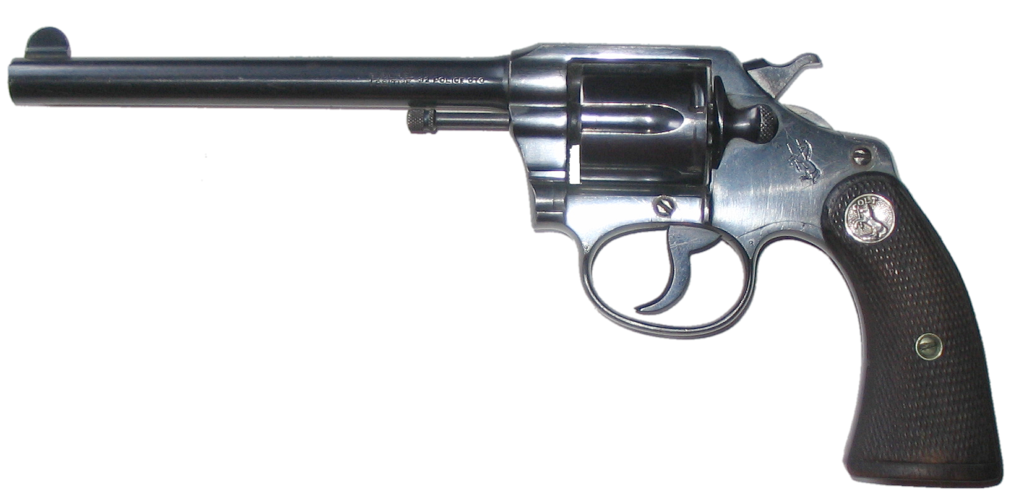
Each of the 4,500 guns carried a serial number that matched the officer’s badge number and sported “New York Police” engraved on the backstrap—introducing the idea of official personal accountability.
Those little .32s represented a new breed of revolver: double action, with a swing-out cylinder and a plunger-like ejector to discard empty cases.
For once, with the hammer uncocked, you could fire a gun repeatedly just by pulling the trigger a little harder. For the time, they were state of the art.
Gradually, other police departments started investing in and issuing standard sidearms to their officers.
In Northern, more urban states, law enforcement forces were often involved in breaking up strikes, controlling riots and policing illegal activities like drunkenness and prostitution. The .38 Special Police Positive and Official Police were common choices.
Interestingly, the Mason-Dixon line—the border between Pennsylvania and Maryland—was also known as the Smith & Wesson Line. It was a pronounced nod to segregation, Jim Crow and the Southern preference for large-caliber revolvers like the Smith & Wesson (S&W) Triple Lock.
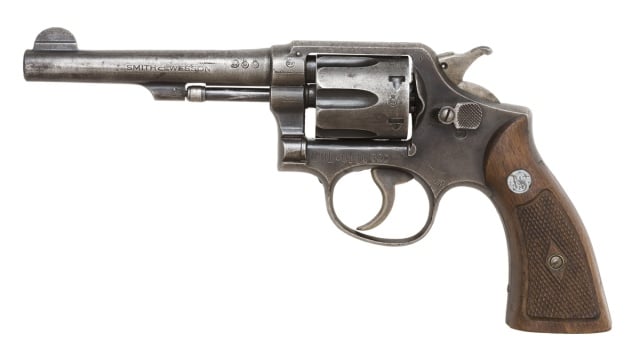
Also known as the .44 Hand Ejector First Model and the New Century, the double-action six-shot Triple Lock came in .38-40, .44-40, and .45 Colt chamberings as well as the .44 Russian and the 44 Special and its 246-grain bullet.
The Triple Lock part referred to three points of added stability—lockups—that made the revolver able to withstand greater firing pressures:
- One at the rear of the cylinder face.
- One at the front of the ejector rod.
- One locking the swing-out yoke into the frame.
While S&W discontinued production after 1915, the Triple Lock was the basis for future generations of large-frame, big-bore S&W revolvers.
G-Men and Magnums
While first formed in 1908, the Federal Bureau of Investigation of the 1930s dealt with the rise of violent crime and notorious personalities like John Dillinger, Bonnie and Clyde, Baby Face Nelson, the Barkers and Al Capone.
In 1934, one year after the repeal of Prohibition, with newly awarded arrest powers, the Bureau officially armed its graduating class of agents with Colt Official Police .38 Specials.
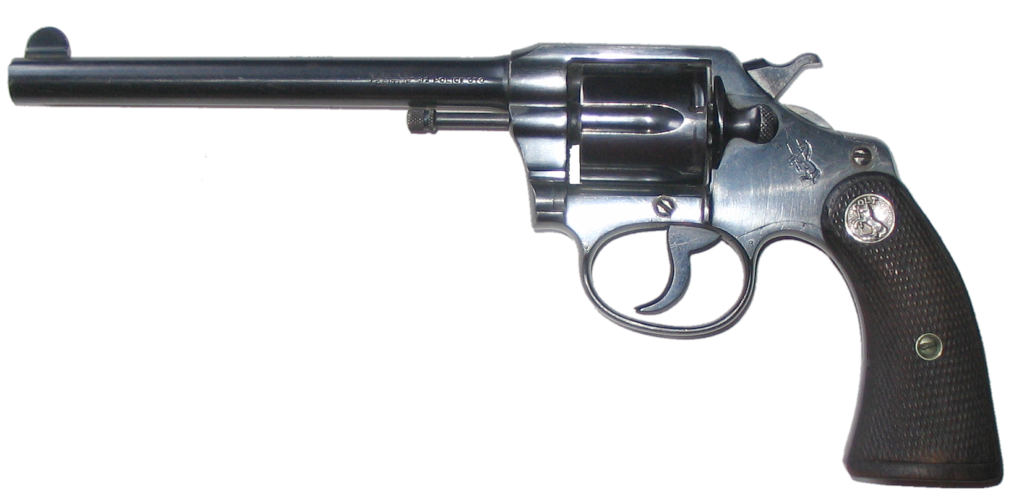
Colt’s Official Police revolver was the gun of choice for many police departments—from cities like San Francisco and Portland, to states like Pennsylvania, Maryland, New Jersey and Connecticut—following its introduction in 1927.
However, the Bureau also subsequently issued S&W .38 Specials as well as Colt Government Model .38 Super Automatics and S&W .357 Registered Magnums, later known as Model 27s.
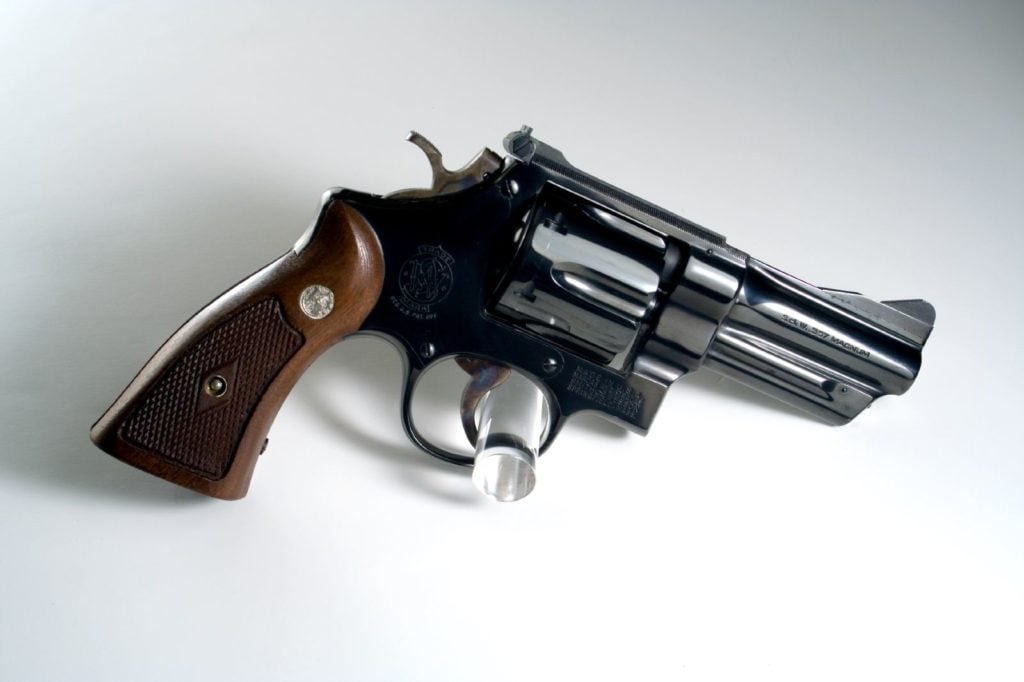
Marketed as “The Most Powerful Handgun in the World,” the .357 N frame Registered Magnum revolver quickly became a Bureau favorite thanks to its superior power and performance.
While it came in 23 different barrel lengths—as well as assorted front and rear sight, finish and grip options—agent guns typically had barrels of 3.5, 4 or 5 inches.
Many police officers adopted the .357, too. Registered Magnums were shipped to law enforcement officers all across the country, including, for example, the:
- Kansas City Police—4-inch barrels.
- Utah Highway Patrol—6½-inch barrels.
- City of Indianapolis Police Department—5-inch barrels.
- Tucson Police Department—three shipments of 12 considered prewar but likely non-registered.
By 1954, the Model 28 Patrolman had evolved as the economy model, minus the little extras—bluing instead of polishing and a bead-blasted matte top strap rather than a cross-hatched, checkered one, for example.
By the 60s, lots of police departments were issuing 6-inch Model 28s, from Columbia, Missouri, to the Washington State Patrol.
“Luxury” or economic, the magnum revolver had become a preferred law enforcement staple that lasted for most departments well into the 1980s.
Shootouts and The Rise of the Semi-Auto
For a long time, semi-automatics were considered both too expensive and not nearly as reliable or effective—think stopping power—as the preferred police revolvers.
Colt’s M1911 pistol was an exception, but it had its drawbacks. The carry method with the hammer cocked and locked required more exacting training and handling practices.
More popular, the S&W Model 39—a 9mm—was ergonomic and slim, with a single-column magazine as well as advanced features like a double-action single-shot trigger, open top slide and slide-mounted decocker.
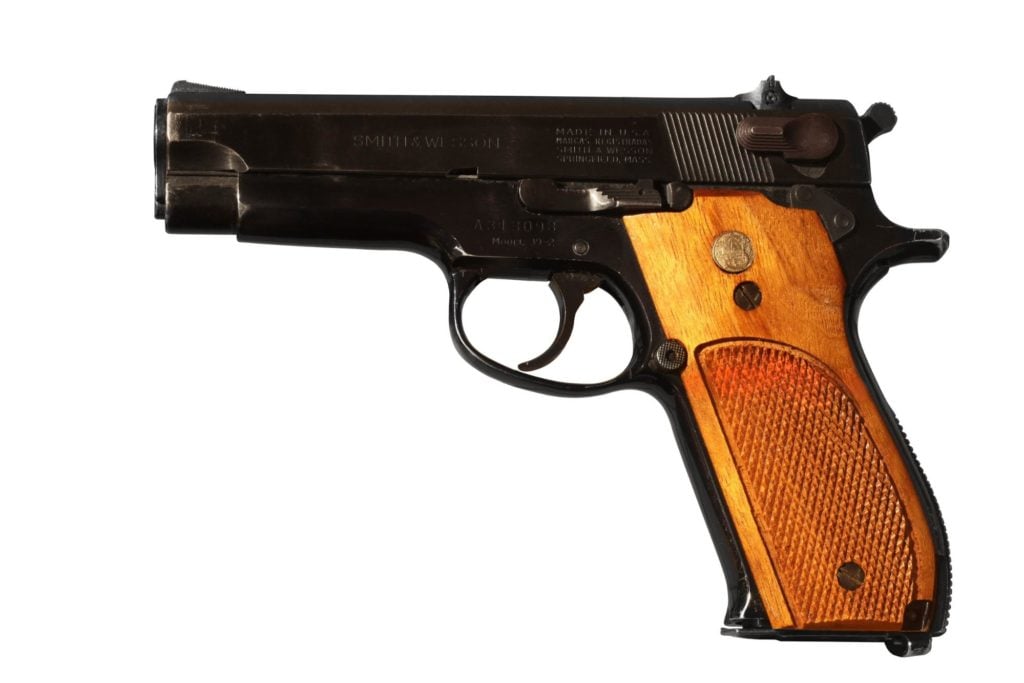
It was that flat profile and enhanced unit efficiency that led the Illinois State Patrol to adopt the Model 39 for its officers in 1967.
Noted as prone to jams, the Model 39 led to the 39-2, which had an improved feed ramp and a shortened, narrowed extractor less prone to breakage. Illinois continued to issue the highly reliable 39-2s for more than a decade.
While the shift from revolvers—or wheel guns—to semis was anything but uniform, two factors sped it up. The first was a shootout in 1986 in Miami, Florida, in which two robbery suspects outgunned eight FBI agents.
In the aftermath of the Miami shootout, the Bureau started searching for a handgun that offered more effective stopping power without cumbersome reloads under fire. At that time, the answer came in the form of the 10mm S&W Model 1076.
As Model 1076s proved a bit ungainly and somewhat unreliable, they gave way to SIG 226s and, later, 228s.
However, the real game changer was the Austrian-made Glock. Offering up to 17 rounds, a mere 5-pound trigger pull, lighter body weight thanks to polymers and fully interchangeable parts, the Glock promised firepower, accurate ease of use and affordability.
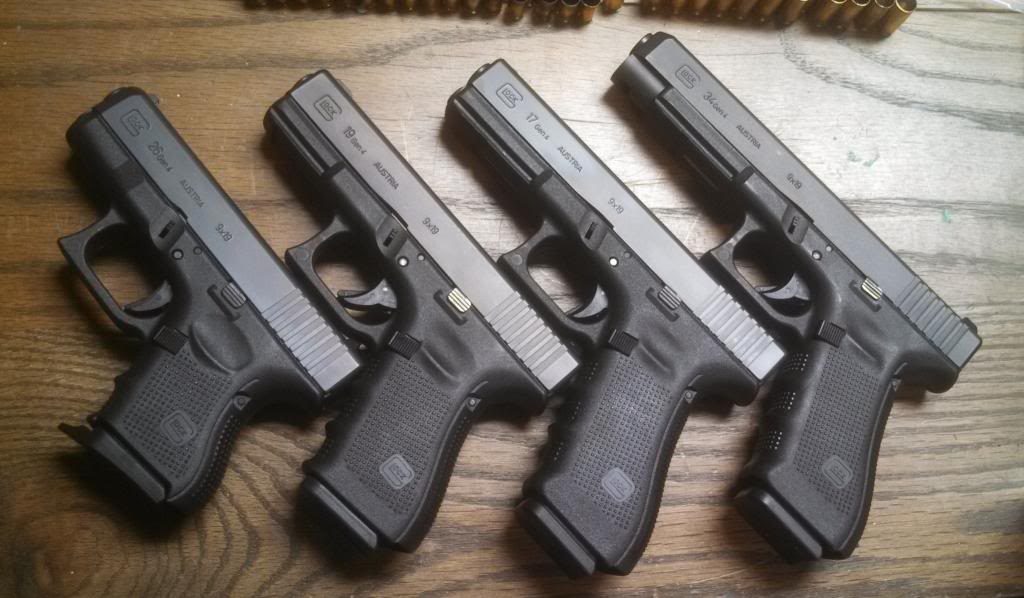
Visit Glock’s site, and you’ll learn that “approximately 65% of police departments in America already put a GLOCK police pistol in between them and the problem.”
Initially, Glock offered police departments its pistols with significant discounts while also launching movie, music and publicity campaigns. Later, the company encouraged departments to upgrade through trade-in programs.
St. Paul, Minnesota, and Miami, Florida, were the first of the large police departments to adopt the Glock. By 1994, the New York Police Department was issuing 2nd Generation Glock 19s, and many other departments—as well as bad guys—quickly followed suit.
Policing Sidearms Today
Today, federal law enforcement agents with the Department of Justice still favor the Glock. The U.S. Marshals Service; Drug Enforcement Administration; Bureau of Alcohol, Tobacco, Firearms and Explosives; and Federal Bureau of Investigation have all issued Glock 22s, 23s and 27s, typically with .40 caliber S&W chambering.
In 2016, Glock closed yet another deal with the Bureau worth $85 million. However, this time it was for specially modified 5th Generation Glock 17s and 19s in 9mm Luger.
To boot, the Bureau had reportedly been contemplating that other popular modern semi—the Sig Sauer P320 which was recently chosen as the new US Army sidearm.
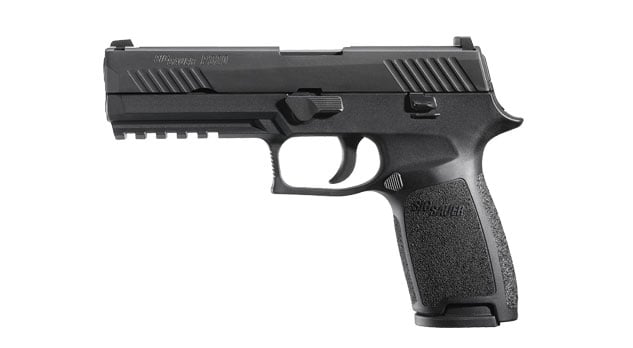
Secret Service agents carry Sig Sauer P229s while Air Marshals have P250s.
At the local level, perhaps the New York Police Department is once again a quite accurate example of police departments across America. It allows its officers three options: the Glock 19, the Sig Sauer P226 and the S&W 5946.
Among law enforcement, these represent the big three in sidearms—Glock, Sig Sauer and S&W—and the three cartridges of choice—9mm, .40 S&W and .45 ACP. However, Ruger, Beretta and Springfield Armory handguns remain in the running, too.
Something to note is that while many agencies and departments issue service weapons, mandating their exclusive use, some departments still require officers to purchase their own sidearms.
When a Police Executive Research Forum survey—part of the National Gun Violence Research Center project—examined service weapon policies and practices at more than 50 of the largest police departments, it found that:
- Officers at 73 percent of the departments carried only semi-automatic weapons, with the remainder carrying either semis or revolvers.
- Nearly 70 percent of the departments—69 percent, to be exact—acquire and provide all weapons for their sworn officers to carry. However, that also means that nearly a third don’t.
- More than half had service weapon providers bid competitively while not quite a quarter relied on sole-source agreements.
- Of the handguns purchased in the previous 5 years, nearly 60 percent of responding agencies had purchased Glocks, 20 percent S&Ws, about 12 percent Sig Sauers and about 6 percent Berettas.
- Sixty-five percent purchased .40-caliber weapons.
- Sixty-three percent purchased 15-round magazines.
So, there you have it—the high points, from Colts to Glocks, from flintlocks to semi-automatics. I hope you enjoyed the tour.
Law enforcement weaponry, ammunition, practices and daily challenges have evolved over the decades, and the only thing certain for the future is that they’ll continue to change—perhaps dramatically.
One reply on “Police Sidearms: From Past to Present By Scott Dylan”
[…] Police Sidearms: From Past to Present By Scott Dylan […]